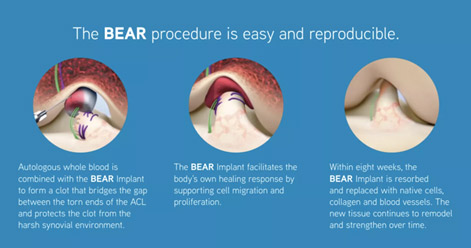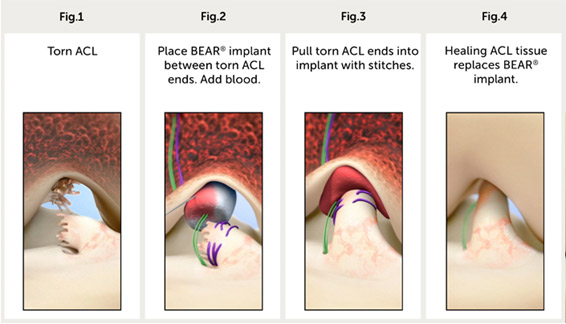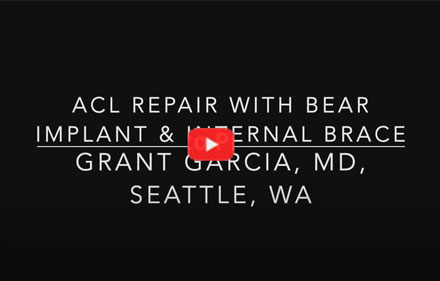BEAR (Bridge Enhanced ACL Restoration) Surgery: An ACL Preservation & Healing Surgery
Dr. Garcia’s updated BEAR ACL repair technique with tightrope fixation
Introduction:
ACL tears are an extremely common injury, which can require extensive downtime and physical therapy. The most common treatment for ACL tears has been reconstruction. More recent data has demonstrated certain ACL tear patterns are amenable to repair and preservation. In these select cases there is a major advantage to repair, including less pain, better proprioception, lower risk associated with graft harvest and implantation.
BEAR Implant Overview
Background:
Dr. Garcia discussion orthopedic innovation including the lengthy process for BEAR approval and how cutting edges implants and surgeries make it to market.
The anterior cruciate ligament, or ACL, is one of the major ligaments of the knee that is in the middle of the knee and runs from the femur (thigh bone) to the tibia (shin bone). It prevents the tibia from sliding out in front of the femur. Together with posterior cruciate ligament (PCL) it provides rotational stability to the knee. An ACL injury is a sports related injury that occur when the knee is forcefully twisted or hyperextended. An ACL tear usually occurs with an abrupt directional change with the foot fixed on the ground or when the deceleration force crosses the knee. Changing direction rapidly, stopping suddenly, slowing down while running, landing from a jump incorrectly, and direct contact or collision, such as a football tackle can also cause injury to the ACL. When you injure your ACL, you might hear a "popping" sound and you may feel as though the knee has given out. Within the first two hours after injury, your knee will swell, and you may have a buckling sensation in the knee during twisting movements.
Symptoms
When you injure your ACL, you might hear a loud "pop" sound and you may feel the knee buckle. Within a few hours after an ACL injury, your knee may swell due to bleeding from vessels within the torn ligament. You may notice that the knee feels unstable or seems to give way, especially when trying to change direction on the knee.
Dr. Garcia talks all ACL surgery options on Health Matters.
Diagnosis
An ACL injury can be diagnosed with a thorough physical examination of the knee and diagnostic tests such as X-rays, MRI scans and arthroscopy. X-rays may be needed to rule out any fractures. In addition, your doctor will often perform the Lachman’s test to see if the ACL is intact. During a Lachman test, knees with a torn ACL may show increased forward movement of the tibia and a soft or mushy endpoint compared to a healthy knee. Pivot shift test is another test to assess ACL tear. During the pivot shift test, if the ACL is torn the tibia will move forward when the knee is completely straight and as the knee bends past 30° the tibia shifts back into correct place in relation to the femur.
The future of ACL surgery is coming. Our recent podcast discusses the new BEAR implant and ACL repair techniques with the same goal: Save the ACL and improve outcomes.
Does the ACL Heal After Tearing?
Unlike many other ligaments in the body, the ACL does not have the ability to heal on its own. A thick liquid – called synovial fluid – reduces friction between the bones when you move your knee. As important as this fluid is for proper knee function, it also prevents the formation of blood clots that are critical for healing. As a result, ACL tears are often treated with surgery. The first innovation in ACL surgery in several decades is bridge-enhanced ACL restoration with the BEAR® Implant.
What is the Bear Implant?
The BEAR Implant is the first medical advancement to enable your body to heal its own torn ACL. The implant is made of collagen and is resorbed by your body within eight weeks of surgery.
How does the BEAR Implant work?
The BEAR Implant works with your own blood to heal the torn ends of your ACL back together. During the procedure, the ACL surgeon adds your own blood to the BEAR Implant and inserts it between the torn ends of your ACL. The implant holds and protects the blood to allow the formation of a clot. Over the next eight weeks, the BEAR Implant is resorbed by your body and replaced with native ACL tissue. Dr. Grant Garcia is one of the few surgeons in Washington State that performs this surgery.

How is the BEAR Implant different from ACL reconstruction?
ACL tears are often treated with surgery called ACL reconstruction, also known as ACL replacement surgery. During ACL reconstruction, an orthopedic surgeon removes the torn ACL and replaces it with a graft from another part of the body (called an autograft) or a deceased donor (called an allograft). Although ACL reconstruction is effective, the procedure has drawbacks.
- ACL reconstruction:
- Standard of care proven to be safe and effective
- requires incision to harvest the graft; other work done arthroscopically
- requires graft harvest of patient's own tendon or cadaver tissue is used
- remaining ACL tissue is removed
- BEAR Restoration:
- Use of an FDA-approved bridging scaffold to repair the torn ACL
- requires incision to insert scaffold; other work done arthroscopically
- no graft harvest of patient's tendon
- remaining ACL tissue is preserved

Can anyone get the BEAR Implant?
You may be a candidate for the BEAR Implant if you meet these criteria:

Describe the BEAR Implant Surgery?
Dr. Garcia’s BEAR ACL repair technique with an Internal Brace
- This surgery uses an FDA-approved bridging device to repair the torn ACL ligament called BEAR® Implant.
- A small incision is made in the knee so Dr. Garcia can place the implant using arthroscopic materials. This is placed between the two ends of the ACL to accelerate healing.
- The patient’s own blood will be added to the BEAR implant, and this activates clot formation. The BEAR implant and the blood act as a bridge or conduit for the patient’s cells to migrate and proliferate therefore healing the ACL similar to the way MCL tears heal.
- Finally, the torn ACL ends are sewed to the BEAR implant and secured on both the tibia and femur bones.
What are the benefits of the BEAR Implant?
- Helps your own ACL heal
- Retains normal anatomy and function of the knee
- Simple outpatient procedure
- Does not require a second surgical wound site to remove a healthy tendon from another part of your body or use of a deceased donor’s tendon
- Faster recovery of muscle strength
- Higher patient satisfaction with being ready to return to sports
Patient Testimonial after the BEAR ACL repair
Is the BEAR Implant Better than other Treatment Options?
Both the ACL reconstruction and BEAR implant are effective methods in treating torn ACLs. There are more frequent studies suggesting that this new BEAR technique may have more benefits over time than ACL reconstruction. Here are some potential advantages:
- Some Studies demonstrate that the BEAR implant may provide better hamstring strength at 6 months, 12 months, and two years after the surgery.
- Animal data suggest that using this bioactive implant may reduce the risk of developing posttraumatic osteoarthritis after surgery, but this still must be proven in a human clinical study
- Early data suggest that there may be a lower risk of contralateral tears with the BEAR Implant than ACLR.
Dr. Garcia’s BEAR ACL repair technique with an Internal Brace
What is the recovery time for the BEAR Implant?
The rehabilitation protocol for the BEAR Implant is different from ACL reconstruction, but overall recovery time is similar. Return to high levels of activity and sports is usually around nine months after surgery, which is similar to ACL reconstruction. For more information check out Dr. Garcia physical therapy protocols for the BEAR implant.
The BEAR Implant from Miach Orthopaedics was approved by the U.S. Food and Drug Administration in December 2020. It is indicated for skeletally mature patients at least 14 years of age with a complete rupture of the ACL confirmed by MRI. Patients must have an ACL stump attached to the tibia to facilitate the restoration. The BEAR device must be implanted within 50 days of injury. Visit www.miachortho.com for complete product information, including Instructions for Use. 50 days of injury.
Arthroscopic second look at a successful ACL BEAR repair!



















